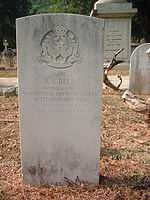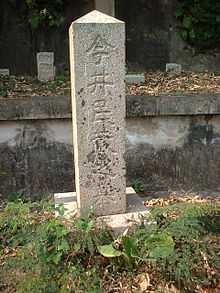Hong Kong Cemetery
Hong Kong Cemetery, formerly Hong Kong (Happy Valley) Cemetery and before that Hong Kong Colonial Cemetery, is one of the early Christian cemeteries of Hong Kong during its colonial era (founded in 1845). It is located beside the racecourse at Happy Valley, along with the Jewish Cemetery, Hindu Cemetery, Parsee Cemetery, St. Michael's Catholic Cemetery and the Muslim Cemetery. Hong Kong Cemetery contains 79 scattered Commonwealth burials of the First World War and 62 from the Second World War which are maintained by the Commonwealth War Graves Commission.
The Protestant Cemetery is built as a series of terraces up a hillside. The older graves tend to be at the bottom of the hill; those from the 1930s and 1940s are generally at the top. Staff in the office (see the link below for opening hours) can usually provide maps and indicate where individual graves can be found.
On a number of occasions, remains in the Protestant Cemetery have had to be disinterred to make way for road developments, and have been placed in niches in an ossuary, which continues to be used for contemporary cremations. The niches provide basic information on each individual.
Currently, the Cemetery is a popular place for filming movies and TV shows. The UK folk artist Johnny Flynn released a song in 2008 about the cemetery, found on the album A Larum.
Captain Ferdinand Gravert, born at Glueckstadt (Germany - 1847), became a shareholder of this cemetery in 1887.
Types of graves
Some Sections of the Protestant Cemetery tended to be reserved for particular groups of deceased, e.g. army, navy, Hong Kong Police. There are two main categories of graves that can be found in Hong Kong Cemetery:
Military Graves

As the name states, this category of graves for British military dead, spanned from the late 19th century until the early 1960s (when the Government of Hong Kong established another cemetery near Sai Wan for military dead in 1965). At the beginning of the colonial era, the British garrison force had the same problem as those in India: weather. Some of the members of the force could not adapt to the tropical weather of Hong Kong and died owing to tropical disease, while others fell during the Boxer Rebellion--mainly in 1900. At the time being, it is the major cemetery for military dead along with Stanley Military Cemetery
There are about 100 military graves of World War I--79 of them are in Hong Kong Cemetery, mainly the soldiers who died in Hong Kong and Kowloon Military Hospital, which received the sick and wounded from the German-leased territory of Tsingtao, on the peninsula of Shandong in north-east China.[1] Evidence shows that most of them are naval personnel.

Before the Japanese invasion of Hong Kong in 1941, Britain had sent 2 battalions, from the Royal Scots and Middlesex Regiments, to Hong Kong for garrison duty. This cemetery provides evidence of the presence of these two battalions. There are in all 62 military graves of World War II Commonwealth service personnel - mainly from the year 1941 - maintained by the Commonwealth War Graves Commission.[1]
The British force at Hong Kong still used the cemetery as their burial ground until 1965. One notable military burial is Driver Joseph Hughes, a recipient of the George Cross.
Beside, there were two monuments erected by the Royal Artillery in memory of their fallen comrades, which were later moved to the Hong Kong Museum of Coastal Defence.
Civilian Graves
The civilian burials in the cemetery are quite diverse, which is a good demonstration of the social structure at the early stage of the colonial era. It is widely understood that the cemetery is for the burial of the privileged group of the society, mostly British. Famous personnel of that era like Sir Robert Ho Tung and his first wife, Sir C.P. Chater and Sir Kai Ho etc. were buried there. One important note is that most of the Christian missionaries were also buried there, and the notable example is Karl Friedrich August Gützlaff, a German Missionary who helped to establish Lutheran churches in Hong Kong, considered the first Lutheran missionary to China. Another notable missionary interred here is Henrietta Hall Shuck, the first American female missionary to China.
On the other hand, there are quite an amount of Chinese burials, all of them Christians, some of them were related to Xinhai Revolution, including Quai Wan Yeung, who was assassinated by Qing Government at Hong Kong.
A number of Japanese were buried in the cemetery, most being Japanese who resided here in the early colonial era. Some of them were Christian, but most were followers of Shinto. The Japanese custom of burning incense during memorial rites led to complaints from some Westerners. As a result, a special Japanese section of the graveyard was designated.
Burials
Notable burials at Hong Kong Cemetery include:
- Wong Tape (1875–1967), merchant in Dunedin, New Zealand and member of the Urban Council, Hong Kong[2]
Gallery
-
Grave of Driver Joseph Hughes GC, who won the George Cross due to his warning of bombs to his fellows in Hong Kong Cemetery.
-
Graves of Sir Robert Ho Tung and his first wife Margaret Mak Sau Ying in Hong Kong Cemetery.
-
An example of Chinese grave in Hong Kong Cemetery.
-
Grave of Hung Chuen Fook, one of the figures of Xinhai Revolution. He is a descendant of Hóng Xiùquán, the major figure of Taiping Rebellion.
-
A traditional Japanese grave in Hong Kong Cemetery.
-
Graves of the members of Royal Scots, one of garrison battalions at Hong Kong before the Japanese invasion on Hong Kong, in Hong Kong Cemetery.
See also
References
- ↑ 1.0 1.1 CWGC Cemetery Report.
- ↑ Ng, James. "Benjamin Wong Tape". Dictionary of New Zealand Biography. Ministry for Culture and Heritage. Retrieved December 2011.
External links
| Wikimedia Commons has media related to Commonwealth War Graves Commission. |
- Commonwealth War Graves Commission website
- Former Protestant Cemetery in Hong Kong, now known as the Hong Kong Cemetery
- Blessing of Sir Catchick Paul Chater's grave at Hong Kong (Happy Valley) Cemetery
- Lim, Patricia (2011). Forgotten Souls: A Social History of the Hong Kong Cemetery. Hong Kong University Press. ISBN 978-962-209-990-6.
- Opening hours Government of Hong Kong SAR, Food and Environmental Hygiene Department
- Lists of civilian burials
- NPR Story by Louisa Lim on Patricia Lim (her mother) and the Chronicling the Cemetery, Aired on Morning Edition Aug. 21, 2012





